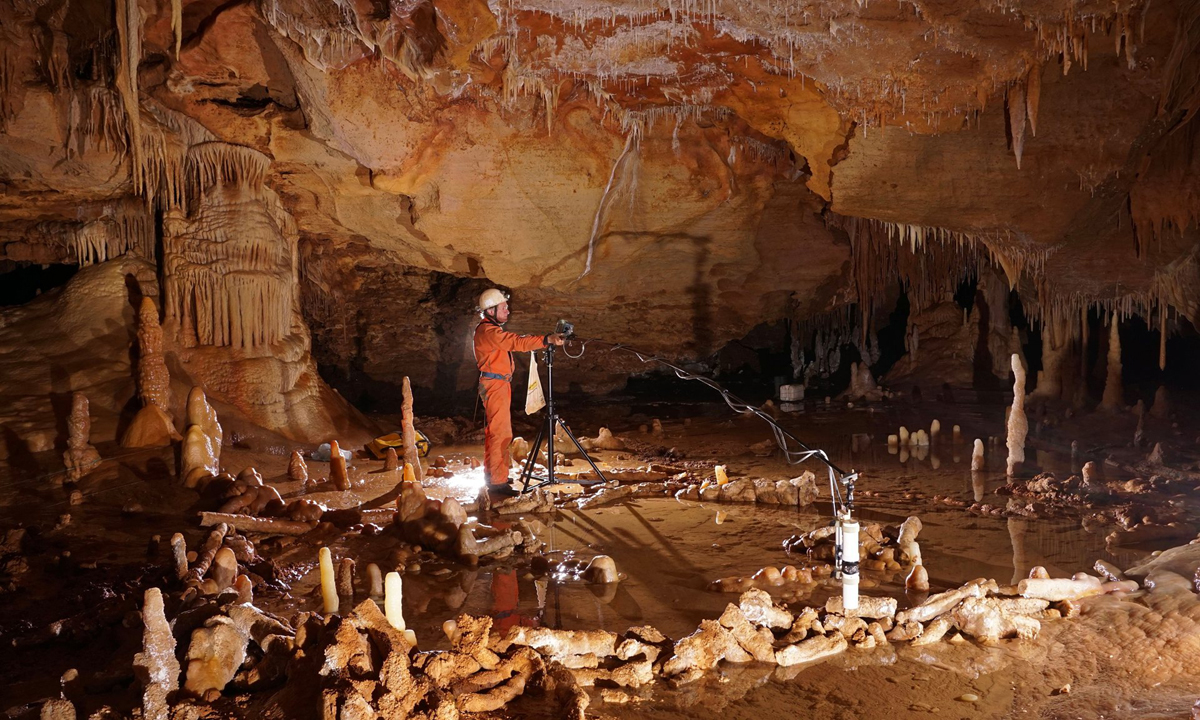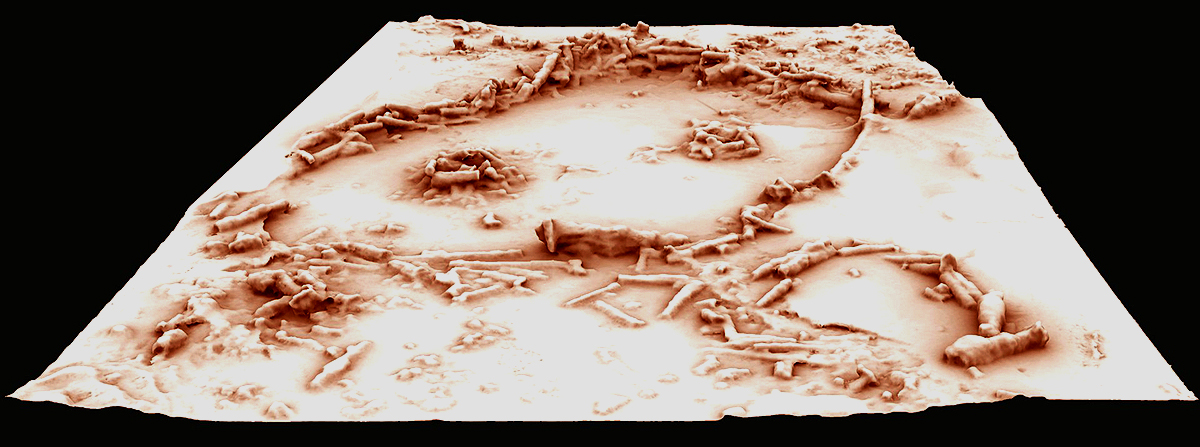


An article by Science Editor Ian Sample on the Guardian.com - Neanderthals built mysterious cave structures 175,000 years ago - reports on the constructions discovered deep in a French cave, ranking among the earliest human building projects ever discovered. Their purpose, however, remains unclear.

Parts of the walls show clear signs of fire damage, with the stalagmites blackened or reddened, and fractured from the heat, leading researchers to suspect that the Neanderthals embedded fireplaces in the structures to illuminate the cave. Image: Etienne Fabre/SSAC
Mysterious structures found deep inside a French cave are the work of Neanderthal builders who lived in the region more than 100,000 years before modern humans set foot in Europe.
The constructions are made from nearly 400 stalagmites and stacked on top of one another to produce rudimentary walls on the cave floor.

A 3D reconstruction of the structures in the Bruniquel cave. Image: Xavier Muth/Get in Situ, Archeotransfert, Archeovision -SHS-3D
The most prominent formations are two ringed walls, built four layers deep in places, with stalagmites wedged in place as vertical stays. The largest of the walls is nearly seven metres across and, where intact, stands up to 40cm high.
"This is completely different to anything we have seen before. I find it very mysterious," said Marie Soressi, an archaeologist at Leiden University, who was not involved in the research. Unique in the history of Neanderthal achievements, the structures rank among the earliest human building projects ever discovered.
Neanderthal cave structures discovered. Earliest constructionshttps://t.co/ZjsHdDvPsx pic.twitter.com/AGUrajJKq8
— Bradshaw Foundation (@BradshawFND) May 26, 2016
The ringed walls are made from nearly 400 stalagmites that have been pulled from the ground and stacked on top of one another. Image: Michel Soulier/SSAC
Parts of the walls show clear signs of fire damage, with the stalagmites blackened or reddened and fractured from the heat, leading researchers to suspect that the Neanderthals embedded fireplaces in the structures to illuminate the cave.
Local cavers happened on the mysterious formations in the 1990's, more than 300m from the entrance to the Bruniquel cave, near the Pyrenees mountains in southwest France. At that time, the stalagmite structures were assumed to be 50,000 years old, the same age as burnt animal remains found nearby.
However, fresh tests on the structures, reported in the journal Nature, reveal the simple walls to be much older than thought. Stalagmite tips and pieces of charred bone found in the walls date them to at least 175,000 years ago. According to French and Belgian scientists who led the research, only Neanderthals could have built the structures.
Neanderthals lived in Eurasia from about 400,000 to 40,000 years ago and died out just as modern humans arrived in the region. The Neanderthals harnessed fire, lived in shelters, wore clothes, and mastered the art of stone tool making. They buried their dead, and adorned the graves with offerings such as flowers. The Neanderthals used sea shells as jewellery, painting them with mineral pigments and probably threading them on strings. They also made glue?by careful burning of tree bark to help fix their sharp stone tips to spear shafts.
But this appears the first evidence of Neanderthal construction. The site is remarkably well preserved because the stalagmites became encased in calcium carbonate soon after the walls were built.
The purpose? The researchers claim that "all options are open". Questions, such as what were Neanderthals doing so deep inside the cave where the lack of natural light would have left them in total darkness without fires to illuminate the space, are numerous.
Read more in the ORIGINS section:
by Bradshaw Foundation
Tuesday 21 March 2023
by Bradshaw Foundation
Tuesday 07 February 2023
by Bradshaw Foundation
Thursday 19 May 2022
by Bradshaw Foundation
Tuesday 19 October 2021
by Bradshaw Foundation
Friday 25 June 2021
by Bradshaw Foundation
Monday 09 November 2020
by Bradshaw Foundation
Tuesday 03 November 2020
by Bradshaw Foundation
Wednesday 28 October 2020
by Bradshaw Foundation
Tuesday 23 June 2020
by Bradshaw Foundation
Thursday 04 June 2020
by Bradshaw Foundation
Thursday 14 May 2020
by Bradshaw Foundation
Tuesday 12 May 2020
by Bradshaw Foundation
Wednesday 19 February 2020
by Bradshaw Foundation
Tuesday 21 January 2020
by Bradshaw Foundation
Monday 20 January 2020
by Bradshaw Foundation
Thursday 28 November 2019
by Bradshaw Foundation
Tuesday 21 March 2023
by Bradshaw Foundation
Tuesday 07 February 2023
by Bradshaw Foundation
Thursday 19 May 2022
by Bradshaw Foundation
Tuesday 19 October 2021
by Bradshaw Foundation
Friday 25 June 2021
by Bradshaw Foundation
Monday 09 November 2020
by Bradshaw Foundation
Tuesday 03 November 2020
by Bradshaw Foundation
Wednesday 28 October 2020
by Bradshaw Foundation
Tuesday 23 June 2020
by Bradshaw Foundation
Thursday 04 June 2020
by Bradshaw Foundation
Thursday 14 May 2020
by Bradshaw Foundation
Tuesday 12 May 2020
by Bradshaw Foundation
Wednesday 19 February 2020
by Bradshaw Foundation
Tuesday 21 January 2020
by Bradshaw Foundation
Monday 20 January 2020
by Bradshaw Foundation
Thursday 28 November 2019
Friend of the Foundation











